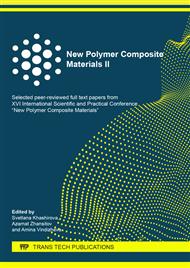[1]
M. Elimelech, The global challenge for adequate and safe water, J. Water Supply Res. Technol. - AQUA. 55 (2006) 3-10.
DOI: 10.2166/aqua.2005.064
Google Scholar
[2]
M.A. Shannon, et al., Science and technology for water purification in the coming decades. Nature 452 (2008) 301-310.
Google Scholar
[3]
M.C.M. Van Loosdrecht, D. Brdjanovic, Anticipating the next century of wastewater treatment, Science. 344 (2014) 1452-1453.
DOI: 10.1126/science.1255183
Google Scholar
[4]
S.B. Grant, et al., Taking the waste' out of 'wastewater, for human water security and ecosystem sustainability, Science. 337 (2012) 681-686.
Google Scholar
[5]
W.J. Macknight, E.A. Ponomarenko, D.A. Tirrell, Self-Assembled Polyelectrolyte - Surfactant Complexes in Nonaqueous Solvents and in the Solid State, Acc. Chem. Res. 31 (1998) 781-788.
DOI: 10.1021/ar960309g
Google Scholar
[6]
P.M. Claesson, E. Poptoshev, E. Blomberg, A. Dedinaite, Polyelectrolyte-mediated surface interactions, Adv. Colloid Interface Sci. 114-115 (2005) 173-187.
DOI: 10.1016/j.cis.2004.09.008
Google Scholar
[7]
P. Bertrand, A. Jonas, A. Laschewsky, R. Legras, Ultrathin polymer coatings by complexation of polyelectrolytes at interfaces: suitable materials, structure and properties Scheme of the electrostatic layer-by-layer self-assembly (ESA), Macromol. Rapid Commun 21 (2000).
DOI: 10.1002/(sici)1521-3927(20000401)21:7<319::aid-marc319>3.0.co;2-7
Google Scholar
[8]
B. Schille, N.O. Giltzau, R. Francke, Zur Nutzung von Polyelektrolyten und Polymediatoren in der organischen Elektrosynthese, Angew. Chemie. 130 (2017) 429-433.
DOI: 10.1002/ange.201710659
Google Scholar
[9]
B. Bolto, J. Gregory, Organic polyelectrolytes in water treatment, Water Res. 41 (2007) 2301-2324.
DOI: 10.1016/j.watres.2007.03.012
Google Scholar
[10]
J. Penelle, T. Xie, Synthesis, characterization, and thermal properties of poly(trimethylene-1,1-dicarboxylate) polyelectrolytes, Macromolecules. 34 (2001) 5083-5089.
DOI: 10.1021/ma002176r
Google Scholar
[11]
P. Sikorski, E.D.T. Atkins, L.C. Kagumba, J. Penelle, Structure and morphology of poly(diethyl trimethylene-1,1-dicarboxylate) crystals, Macromolecules. 35 (2002) 6975-6984.
DOI: 10.1021/ma020486z
Google Scholar
[12]
N. Illy, et al., Synthesis and Solid-State Properties of PolyC3 (Co)polymers Containing (CH2-CH2-C(COOR)2) Repeat Units with Densely Packed Fluorocarbon Lateral Chains, Macromolecules. 52 (2019) 9199-9207.
DOI: 10.1021/acs.macromol.9b01559.s001
Google Scholar
[13]
M.A.V. Axelos, M.M. Mestdagh, J. Francois, Phase Diagrams of Aqueous Solutions of Polycarboxylates in the Presence of Divalent Cations, Macromolecules. 27 (1994) 6594-6602.
DOI: 10.1021/ma00100a052
Google Scholar
[14]
N. Elhalawany, C. Négrell, N. Illy, B. Brissault, J. Penelle, Preliminary investigations on a simple polyelectrolyte derived from (CH2CH2C(COOH)2)n: Unexpected solubility-insolubility pattern controlled selectively by the nature of the alkali counterion, Polymer. 116 (2017) 515-522.
DOI: 10.1016/j.polymer.2017.02.043
Google Scholar
[15]
A. Benlahouès, Développement de méthodologies de synthèse innovantes pour l ' obtention de chimiothèques de polyélectrolytes (2018).
Google Scholar
[16]
N. Piazzon, M. Rosenthal, A. Bondar, D. Spitzer, D.A. Ivanov, Characterization of explosives traces by the Nanocalorimetry, J. Phys. Chem. Solids. 71 (2010) 114-118.
DOI: 10.1016/j.jpcs.2009.07.032
Google Scholar
[17]
A.P. Melnikov, et al., Re-exploring the double-melting behavior of semirigid-chain polymers with an in-situ combination of synchrotron nano-focus X-ray scattering and nanocalorimetry, Eur. Polym. J. 81 (2016) 598-606.
DOI: 10.1016/j.eurpolymj.2015.12.031
Google Scholar
[18]
A.P. Melnikov, M. Rosenthal, D.A. Ivanov, What Thermal Analysis Can Tell Us about Melting of Semicrystalline Polymers: Exploring the General Validity of the Technique, ACS Macro Lett. 7 (2018) 1426-1431.
DOI: 10.1021/acsmacrolett.8b00754
Google Scholar
[19]
G. Ashiotis, et al., The fast azimuthal integration Python library: PyFAI, J. Appl. Crystallogr. 48 (2015) 510-519.
DOI: 10.1107/s1600576715004306
Google Scholar
[20]
K. Nakamoto, Infrared and Raman Spectra of Inorganic and Coordination Compounds, Part B. (Wiley).
Google Scholar
[21]
G.B. Deacon, R.J. Phillips. Relationships between the carbon-oxygen stretching frequencies of carboxylato complexes and the type of carboxylate coordination, Coord. Chem. Rev. 33 (1980) 227-250.
DOI: 10.1016/s0010-8545(00)80455-5
Google Scholar
[22]
W.R. Feairheller, J.E. Katon, The vibrational spectra of acrylic acid and sodium acrylate. Spectrochim, Acta Part A Mol. Spectrosc. 23 (1967) 2225-2232.
DOI: 10.1016/0584-8539(67)80114-4
Google Scholar


